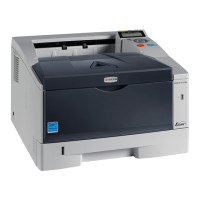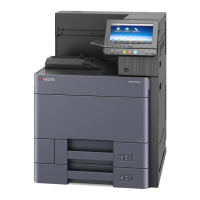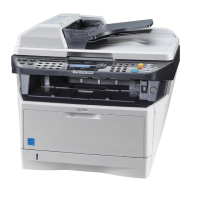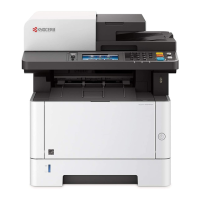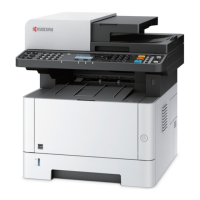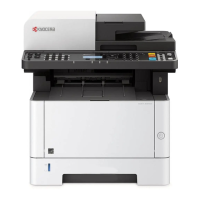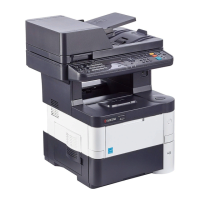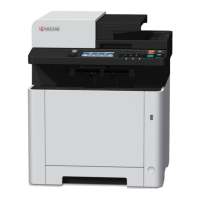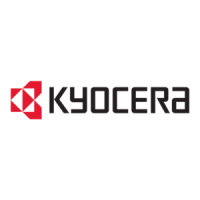
Do you have a question about the Kyocera ECOSYS PA5500 Series and is the answer not in the manual?
| Brand | Kyocera |
|---|---|
| Model | ECOSYS PA5500 Series |
| Category | All in One Printer |
| Language | English |
Guidelines for connecting the machine to PCs or tablets via various methods.
Instructions for connecting LAN and USB cables, and power cables.
Procedures for turning the machine's power on and off.
Explanation of the operation panel keys and their functions.
How to configure default machine settings like date, time, and network.
Procedures for configuring wired and wireless network connections.
Steps to set up a wired network connection for the machine.
Steps to configure wireless LAN settings for network connectivity.
Instructions to configure Wi-Fi Direct for direct device connection.
Instructions for downloading and installing software from the website.
Step-by-step guide to downloading and installing software on Windows PCs.
Guide for installing machine software on Mac computers.
Preparations for administrators, including privilege overview and logging in.
Explanation of different administrator privilege levels and their capabilities.
Procedures for logging in with administrator credentials.
Options and settings available for administrators to enhance machine security.
Overview of Command Center RX and how to access it for configuration.
Steps to access the Command Center RX web interface.
How to modify the machine's security settings via Command Center RX.
Procedures to change device information like host name through Command Center RX.
Configuring SMTP settings for sending email notifications from the machine.
Instructions on how to load paper into the machine's cassettes and trays.
How to save and print jobs later from the machine's job boxes.
How to monitor the printer's status and view job information.
Procedures for canceling print jobs that are in progress or waiting.
Instructions for using USB drives to print files directly from the machine.
How to print files from a USB drive plugged into the machine.
How to check the status of jobs being processed or waiting to be printed.
How to review the history of completed print jobs.
How to check the remaining toner and paper levels on the machine.
General guidance on configuring machine settings via the System Menu.
Configuring settings related to paper size, type, and feeding.
Settings that control various aspects of the printing process.
Configuring the machine's network connection settings.
Settings related to the machine's security features and access control.
Settings for managing user authentication and job accounting.
Explanation of how user access is administered and managed on the machine.
Steps to enable and configure user login administration for the machine.
Registering, altering, and deleting users, and configuring login settings.
Configuring user authentication settings when user login is enabled.
How to add new local users to the machine's user list.
Modifying properties for local user accounts with different privilege levels.
Configuring authentication types when ID card authentication is enabled.
How job accounting manages print counts by assigning IDs to accounts.
Steps to enable job accounting for managing print counts.
Adding, changing, and deleting accounts, and setting restrictions for each.
Procedure to add up to 100 individual accounts for job accounting.
How to restrict machine usage by account or available sheets.
Modifying the details of an existing job accounting account.
Procedure to remove a job accounting account from the machine.
Settings for counting printed pages and managing job accounting data.
How to count printed pages and reset counters for total and job accounting.
Procedures for logging in and out when job accounting is enabled.
Procedures for logging into and out of job accounting.
Specifying how the machine behaves when the counter limit is reached.
Routine cleaning procedures to ensure optimal printing quality.
Step-by-step guide for cleaning the machine, including registration rollers and vents.
Instructions for replacing the toner container when it is low or empty.
Procedures for replacing the waste toner box when it becomes full.
General guidelines and checkpoints for solving common machine problems.
Table of common symptoms, checkpoints, and corrective actions for machine issues.
Troubleshooting steps for issues like application not starting or blank sheets being ejected.
Solutions for problems related to printed image quality, such as light, dark, or fuzzy output.
How to remotely operate the machine using a browser or VNC software for troubleshooting.
Steps to perform remote operation using web browsers like Chrome or Edge.
How to start remote operation using VNC software.
Guidance on responding to various error and status messages displayed by the machine.
Procedures for clearing paper jams from different locations within the machine.
Safety precautions and tips to avoid further jamming when clearing jams.
Specific steps for clearing paper jams from the multi-purpose tray.
Procedures for clearing paper jams from any of the machine's cassettes.
Steps for clearing paper jams from the duplex unit.
Instructions for checking and clearing paper jams inside the main unit.
Clearing paper jams from the top tray and inside the rear cover.
Procedures for clearing paper jams from the large capacity feeder.
Clearing paper jams from the duplex unit when a large capacity feeder is attached.
Information on paper sizes, types, and specifications supported by the machine.
Guidelines for selecting paper to ensure good print quality and prevent jams.
Details on printing speed, resolution, operating systems, and emulations.
Procedures for backing up machine data using KYOCERA Net Viewer or Command Center RX.
Overview of security functions available at different Quick Setup levels.
Options to block or unblock machine interfaces like USB and optional slots.
Settings to block or unblock the USB interface connector.
Settings to block or unblock the USB port for USB host devices.
Settings to block or unblock the USB drive slot.
Settings to block or unblock the parallel interface.
Settings for blocking or unblocking optional interfaces.
Settings related to user authentication and account lockout policies.
Configuring account lockout policies, including retries and duration.


